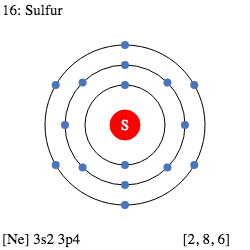
The mass number of the sulphur atom is? (Atomic Number=16 and Number of Neutrons=16)
(A) 18
(B) 32
(C) 24
(D) 16
Answer
570.3k+ views
Hint: An atom is composed of electrons, protons and neutrons. Electrons are the negative charges, Protons are the positive charges and the neutrons are the neutral charges.
Complete step by step solution:
The mass number also called atomic mass number or nucleon number is the total number of protons and neutrons (together known as nucleons) in a nucleus. It is approximately equal to the atomic mass of the atom expressed in Dalton. The protons and neutrons are called baryons. Thus the total mass number A is the total no. of protons and neutrons of an atom or ion. The mass number is different for each different isotope of a chemical element. Hence, the difference between the mass number and the atomic number Z gives the number of neutrons (N) in a given nucleus: N = A − Z.
The atomic number or proton number (symbol Z) of a chemical element is the number of protons found in the nucleus of every atom of that element. The atomic number uniquely identifies a chemical element. It is identical to the charge number of the nucleus.
Thus for Sulphur,
N= 16
Z= 16
Thus, Mass number A= N+Z = 32 amu or Dalton.
The answer is (B).
Additional information:
Sulphur is a multivalent non-metal, abundant, tasteless and odourless. In its native form sulphur is a yellow crystalline solid. In nature, it occurs as the pure element or as sulfide and sulfate minerals.

Note: The number of protons and electrons are the same in any neutral atom. Thus, the atomic number is equal to the number of protons/electrons in a neutral atom.
Complete step by step solution:
The mass number also called atomic mass number or nucleon number is the total number of protons and neutrons (together known as nucleons) in a nucleus. It is approximately equal to the atomic mass of the atom expressed in Dalton. The protons and neutrons are called baryons. Thus the total mass number A is the total no. of protons and neutrons of an atom or ion. The mass number is different for each different isotope of a chemical element. Hence, the difference between the mass number and the atomic number Z gives the number of neutrons (N) in a given nucleus: N = A − Z.
The atomic number or proton number (symbol Z) of a chemical element is the number of protons found in the nucleus of every atom of that element. The atomic number uniquely identifies a chemical element. It is identical to the charge number of the nucleus.
Thus for Sulphur,
N= 16
Z= 16
Thus, Mass number A= N+Z = 32 amu or Dalton.
The answer is (B).
Additional information:
Sulphur is a multivalent non-metal, abundant, tasteless and odourless. In its native form sulphur is a yellow crystalline solid. In nature, it occurs as the pure element or as sulfide and sulfate minerals.

Note: The number of protons and electrons are the same in any neutral atom. Thus, the atomic number is equal to the number of protons/electrons in a neutral atom.
Recently Updated Pages
Master Class 11 Social Science: Engaging Questions & Answers for Success

Master Class 11 Physics: Engaging Questions & Answers for Success

Master Class 11 Maths: Engaging Questions & Answers for Success

Master Class 11 Economics: Engaging Questions & Answers for Success

Master Class 11 Computer Science: Engaging Questions & Answers for Success

Master Class 11 Chemistry: Engaging Questions & Answers for Success

Trending doubts
What is meant by exothermic and endothermic reactions class 11 chemistry CBSE

10 examples of friction in our daily life

One Metric ton is equal to kg A 10000 B 1000 C 100 class 11 physics CBSE

1 Quintal is equal to a 110 kg b 10 kg c 100kg d 1000 class 11 physics CBSE

Difference Between Prokaryotic Cells and Eukaryotic Cells

The camels hump is made of which tissues a Skeletal class 11 biology CBSE




